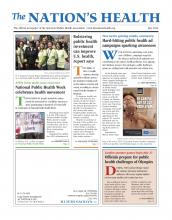With annual advertising costs in the tens of billions, campaigns waged by the tobacco and fast food industries are contributing to the nation’s health problems. Now, tapping into Madison Avenue’s best strategies, public health programs are striking back with innovative ads of their own.
At the federal, state and local levels, public health agencies are using sophisticated, targeted strategies to deliver hard-hitting ads designed to raise awareness of health issues, spark dialogue and change health behaviors. In some cases, as with the Centers for Disease Control and Prevention’s new Tips from Former Smokers campaign, the haunting voices and hollow faces that are appearing on the nation’s TV screens, billboards and on the Internet are eliciting reactions ranging from praise to shock.

One of the ads in CDC’s Tips from Former Smokers campaign, which uses graphic, hard-hitting images to raise awareness.
Graphic courtesy Centers for Disease Control and Prevention
Launched in March, CDC’s Tips from Former Smokers campaign is the federal government’s most ambitious attempt to date to win the battle against the leading cause of preventable death. The first federally funded anti-smoking campaign, Tips from Former Smokers uses graphic stories of real people living with the complications of tobacco-related diseases. In one ad, Brandon, 31, tells how he started smoking at 18 and has lost both of his legs and several fingertips to Buerger’s, a smoking-related disease. In another ad, three smokers who developed throat cancer explain the difficulties of shaving, showering and eating with a stoma, or surgical opening in the neck.
Public health leaders across the nation are praising the campaign, which was made possible through funds provided by the Affordable Care Act’s Prevention and Public Health Fund.

In a Tips from Former Smokers ad, a man relates how he lost both of his legs because of a smoking-related disease.
Graphic courtesy Centers for Disease Control and Prevention
“Research has found that the most effective media campaigns evoke strong emotions and realistically depict the devastating health consequences of tobacco use — just as these new ads do,” Matthew Myers, president of Campaign for Tobacco-Free Kids, said in a statement.
While such ads are increasing in popularity, hard-hitting tactics are not new in health campaigns. In 2000, Legacy’s “truth” anti-tobacco campaign used body bags in its ads to illustrate the number of deaths from smoking.

An ad from 2006’s Infect “truth” campaign featured a cowboy with a throat stoma.
Graphic courtesy Legacy
“Over the last 20 years there has been an increasingly large and increasingly diverse, broad and deep evidence base surrounding the benefits of comprehensive national media campaigns,” Tim McAfee, MD, MPH, director of CDC’s Office on Smoking and Health, told The Nation’s Health.
A 2008 National Cancer Institute review of the evidence base concluded that ads that carry strong negative messages about health consequences are more effective than many other forms of advertising, such as humorous or emotionally neutral ads.
Lessons learned from Australia — where residents suffer the highest skin cancer rates in the world — show that in-your-face ads resonate with the public. For example, Cancer Council Victoria’s SunSmart campaign, which launched in the 1980s, started with positive messages. But as the public became more aware, the approach has become harsher, with graphic messages telling people how to identify the warning signs of skin cancer.

In New York City, subway posters spotlight portion sizes and their health consequences.
Graphic courtesy New York City Department of Health and Mental Hygiene
CDC officials had initially estimated that the agency’s Tips from Former Smokers campaign would drive at least 50,000 people to quit successfully, McAfee said, but based on the campaign’s success in the first month, “the effect is probably going to be larger than that.”
Within two weeks of the campaign’s launch in mid-March, calls to CDC’s toll-free quit line more than doubled and visits to the federal government’s online quit line, at www.smokefree.gov , tripled. And the number continues to grow. Over a one-week period in early May, almost 30,400 people called the quit line, which is more than double the weekly rate preceding the campaign.
“They are clearly helping to encourage people to make quit attempts and they are also supporting people that are actively trying,” McAfee said. “We heard from smokers that we talked with who were engaged in trying to quit that it helped them to keep their motivation up, it helped remind them why it was so important for them to be successful.”
In November 2010, the U.S. Food and Drug Administration announced new, evidence-based tobacco control initiatives to make health warnings on cigarette packages larger and more prominent. Studies show that such graphic warnings have worked well in Europe. Unfortunately, the FDA initiative has become mired down in the courts.
“It will be a tragedy if the United States is one of the few industrialized nations in the world that doesn’t have a graphic warning label on its cigarettes, and that the reason we don’t have it is because it interferes with the ‘commercial speech’ of the tobacco industry,” said Cheryl Healton, DrPH, president and chief executive officer of Legacy.
Tobacco is not the only public health issue being targeted by hard-hitting advertisements. Health campaigns are also using such ads to tackle the nation’s obesity problem and counter ads from the fast food industry.
According to a 2010 study by Yale Rudd Center for Food Policy and Obesity, the nation’s fast food industry spent more than $4.2 billion on advertising in 2009. Obesity now affects 17 percent of all children and teens in the United States — triple the rate from just one generation ago, according to federal statistics.
“Childhood obesity is a problem more than 30 years in the making,” said Stephanie Walsh, MD, medical director of child wellness at Children’s Healthcare of Atlanta and an assistant professor at Emory University School of Medicine. “The deck is stacked against today’s kids.”
To reverse the trend, Children’s Healthcare of Atlanta — Georgia’s largest pediatric center — recently launched Strong4Life. The multi-year movement aims to increase parental awareness of childhood obesity and improve children’s health in the state with the highest rate of childhood obesity in the nation. The first phase of the movement, called “Stop Sugarcoating,” featured a series of frank messages delivered by obese children. For example, one black-and-white poster of a girl proclaimed, “It’s hard to be a little girl when you’re not.”
Some viewers said the ads, directed at parents, were overly negative, but the campaign’s developers maintain that the epidemic of childhood obesity calls for “tough love.”
“We felt we needed to be hard-hitting because this is such a serious issue, and if you have such a serious issue, the need to raise awareness is important,” Walsh told The Nation’s Health. “We had to be tough about it.”
The organization’s research found that more than half of parents do not see childhood obesity as a serious problem, and 75 percent of parents with an overweight or obese child do not think the child has a weight issue. In focus groups conducted by the hospital, children said that they wanted to hear things “straight up,” Walsh said, while parents wanted softer messages.
Research indicated that the ads increased awareness. More than 80 percent of people who saw the ads agreed with their messages, and some noted that the ads opened the door to difficult conversations at home about obesity.
“We’re not talking about the kid who is 30 pounds overweight,” Walsh said. “We are talking about the 11- or 12- or 13-year-olds who are winding up with Type 2 diabetes or hypertension.”
The link between obesity and Type 2 diabetes is driving another hard-hitting public health ad campaign in New York City. Launched in January by the New York City Department of Health and Mental Hygiene, the campaign uses subway posters to spotlight increasing portion sizes and the devastating health consequences they are bringing. In one poster, a man with Type 2 diabetes and an amputated leg sits beside a graphic of three soft drink cups, each growing progressively larger to illustrate how soda portion sizes have increased over time. The text reads: “Cut your portion. Cut your risk.”
“The portion sizes that are marketed are often much more than humans need,” New York City Health Commissioner Thomas Farley said in a statement. “We are warning people about the risks of super-size portions so they can make more informed choices about what they eat.”
For more, visit www.cdc.gov/tobacco/campaign/tips, www.strong4life.com or www.nyc.gov.
- Copyright The Nation’s Health, American Public Health Association









